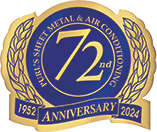According to the US Environmental Protection Agency, the air quality inside homes and other buildings is often three to five times worse than the air outdoors. This goes against what most people think of pollution, but it’s true. And low indoor air quality is a serious problem. The EPA lists various short-term and long-term negative effects of indoor air quality, including:
- Short term: irritation of the eyes, nose, and throat, headaches, dizziness, fatigue
- Long-term: respiratory diseases, heart disease, cancer
We offer indoor air quality services, such as air filters, for our customers to help them enjoy better health and greater comfort in their homes. In this post, we’ll explain exactly why people need this help: the causes and the sources of low indoor air quality (IAQ).
Lack of fresh air circulation (poor ventilation)
The main cause of poor air quality today is the way buildings are constructed. The modern home is built with a strong heat seal on it to prevent the loss of heat in cold weather and the gain of heat in hot weather. This makes the home more energy-efficient and easier to keep at a comfortable temperature. But it also prevents the movement of fresh air through the home. This allows for indoor contaminants to build up in concentration without any way to escape.
Increase in sources of indoor pollutants
Combined with the lack of fresh air circulation, there are more sources of indoor contaminants inside homes than ever before. You probably don’t realize how many products and materials in your house create air pollutants that will quickly grow in concentration without enough ventilation. Here is an incomplete list of sources of airborne pollutants inside many homes:
Many building materials, including carpet, upholstery, pressed wood, asbestos-containing insulation
- Varnishes and paints
- Radon, which naturally occurs beneath many homes
- Pesticides
- Cleaning products
- Cosmetics
- Emissions from HVAC systems
- Fuel-burning and combustion appliances
- Tobacco smoke
- Mold
The pollutants that come from these sources include volatile organic compounds (VOCs), smoke, lead, toxic mold spores, bacteria, and carbon monoxide.
What you can do to improve indoor air quality
Improving the ventilation in your house is one of the best ways to start with removing many of its pollutants. This is one of the reasons we stress with customers to always have their HVAC equipment regularly maintained and repaired/replaced as necessary. And always change the air filter for your HVAC system every one to three months: this filter doesn’t improve IAQ but it will make it worse if it becomes clogged. Regular duct cleaning (every three to five years) also improves ventilation and helps with healthier air circulation.
However, there are limits to what you can do with just allowing more air into your house. We recommend installing high-quality whole-house with our air filter services in Clovis as well as looking into installing an air purifier. The right combination of filters and purifiers can remove more than 98% of the unwanted pollutants circulating around your house. We’re glad to talk to you about your options for IAQ installations and ways we can help you improve your ventilation.
Contact Purl’s Sheet Metal & Air Conditioning for indoor air quality services. Uncompromised Quality & Customer Service Since 1952.


